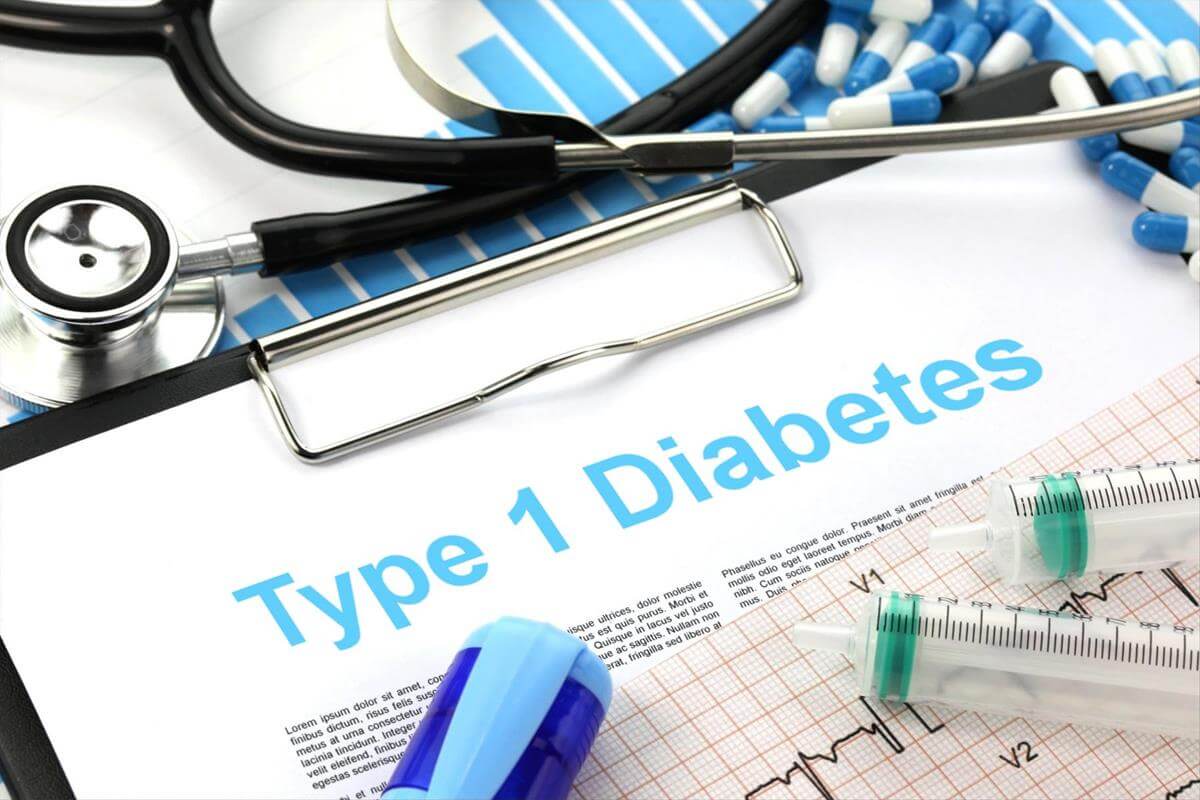Type 1 diabetes is a chronic condition in which your pancreas does not make insulin or makes very little insulin. Formerly known as “juvenile diabetes,” type 1 diabetes is caused by the immune system destroying the cells in the pancreas which make insulin, known as islet cells. Once a significant number of islet cells are destroyed, the pancreas will stop producing insulin. Insulin is a hormone that is necessary for blood sugar to enter the cells of the body to be used for energy. Blood sugar, or glucose, comes from food or the liver. The liver stores glucose as glycogen. If glucose levels are low, the liver will break down glycogen into glucose to keep glucose at normal levels. If the pancreas does not produce insulin, blood sugar will build up in the bloodstream, causing damage to the body.
Type 1 disease has no known cause. Although there are similarities between type 1 and type 2 diabetes, the causes and treatments of both are different. Type 1 diabetes may be caused by genetics. It may also be caused by exposure to viruses or other environmental factors. About 5 percent of people in the United States have type 1 diabetes. It typically first occurs in children and young adults, although it can be diagnosed at any age.
Uncontrolled type 1 diabetes can cause major damage to the organs of the body. Type 1 diabetes can dramatically increase the risk of coronary artery disease with chest pain, heart attack, stroke, high blood pressure, and atherosclerosis (narrowing of the arteries). The walls of the capillaries can be damaged by excess glucose, causing numbness or tingling that begins in the toes and can spread upward, known as peripheral neuropathy. This can result in eventually losing complete sensation in the extremities. Diabetes can also damage the kidneys, causing kidney failure which may lead to end-stage renal disease. End-stage renal disease may require dialysis or, in extreme cases, a kidney transplant. Diabetes can also affect vision. The blood vessels of the retina may be destroyed, and the risk of cataracts or glaucoma may increase. Diabetes may also place you at increased risk of infection, including slow-healing wounds. Extreme cases may result in amputation.
Symptoms of type 1 diabetes include extreme thirst, excessive urination, and unexplained weight loss. Type 1 diabetes can cause a life-threatening condition called diabetic ketoacidosis (DKA). Symptoms of DKA include fruity-smelling breath, nausea, vomiting, stomach pain, or trouble breathing. In DKA, the body will break down fat cells if it is not able to get enough glucose, creating ketones. The liver will also release the glucose it has stored as glycogen. Because the body is not producing insulin, the glucose and ketones will build up, causing ketoacidosis. Ketoacidosis is a life-threatening condition. If you are experiencing symptoms of DKA, seek medical treatment at an emergency room right away.
Providers may diagnose type 1 diabetes through a number of diagnostic blood tests. Your provider will test your A1C level. This test measures your average blood sugar for the past few months. Your A1C level indicates the percentage of blood sugar which is attached to your hemoglobin. An A1c of 6.5 percent or higher, measured on two separate tests, indicates diabetes. Your provider may also take a random blood sugar test and/or fasting blood sugar test. Fasting blood sugars over 126 mg/dL indicate diabetes. Fasting measures between 100 and 125 mg/dL indicate prediabetes. Any random blood sugar test measurement over 200 mg/dl indicates diabetes. Once diabetes is established, your provider may also test your blood for autoantibodies. These substances are often present with type 1 diabetes but not with type 2 diabetes. Your provider may also test your blood for ketones. The presence of ketones is typically an indicator of type 1 diabetes, rather than type 2 diabetes.
Managing type 1 diabetes is often a very involved process for the patient. Type 1 diabetics must take insulin and may need to take more than one different type. Insulin may be administered into the body through a needle and syringe, insulin pen, or insulin pump. People with type 1 diabetes must closely monitor their blood sugar levels. You will have to keep track of your insulin’s onset (how long it takes to enter the bloodstream and start lowering your blood sugar), peak time (when the insulin is doing the most to keep blood sugar low), and duration (how long the insulin continues to work for). There are several different types of insulin available. Long-acting insulin does not enter the bloodstream for a more extended period of time and lasts for about 24 hours. Rapid-acting will begin to work in approximately 15 minutes and will last for 2 to 4 hours after taking it. Regular or short-acting will start in about 30 minutes and keep working for 3 to 6 hours. Intermediate-acting will enter the bloodstream about 2 to 4 hours after injection and last for 12 to 18 hours. In addition to administering insulin, it is important to check your glucose levels frequently. Your provider can give guidance on when you may need to adjust your insulin, food intake, or exercise levels, depending on your glucose levels.
Type 1 diabetes is sometimes very difficult to manage and interferes with some people’s ability to maintain normal work activity. This is especially true if you have suffered through multiple episodes of diabetic ketoacidosis, causing a significant number of days where you are absent from work or need to take frequent breaks throughout the day to administer insulin or check your blood sugars. You may also be experiencing other symptoms such as peripheral neuropathy that are causing you difficulty with your job performance. If this applies to you, you may be eligible for Social Security Disability benefits. The Social Security Disability Lawyer at LaBovick Law Group is experienced in type 1 diabetes cases and can assist you with winning your claim. Do not hesitate to give us a call at (561) 625-8400 for a free case evaluation.




